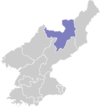Kimhyonggwon County
Geography
Kimhyŏnggwŏn lies on the southeastern edge of the Kaema Plateau, and is covered with mountainous terrain. The Hamgyong Mountains and the Puksubaek Mountains both pass through the county. The highest peak is Paeksan. There are many streams; the chief among them is the Hŏch'ŏn River. Some 88% of the county's area is occupied by forestland.
Climate
| Climate data for Pungsan (1991–2020) | |||||||||||||
|---|---|---|---|---|---|---|---|---|---|---|---|---|---|
| Month | Jan | Feb | Mar | Apr | May | Jun | Jul | Aug | Sep | Oct | Nov | Dec | Year |
| Mean daily maximum °C (°F) | −6.2 (20.8) |
−2.8 (27.0) |
3.1 (37.6) |
11.0 (51.8) |
17.9 (64.2) |
21.6 (70.9) |
23.9 (75.0) |
23.5 (74.3) |
19.2 (66.6) |
13.0 (55.4) |
3.5 (38.3) |
−4.3 (24.3) |
10.3 (50.5) |
| Daily mean °C (°F) | −14.4 (6.1) |
−10.7 (12.7) |
−3.8 (25.2) |
3.9 (39.0) |
10.3 (50.5) |
14.6 (58.3) |
17.9 (64.2) |
17.4 (63.3) |
11.7 (53.1) |
4.6 (40.3) |
−4.0 (24.8) |
−11.9 (10.6) |
3.0 (37.4) |
| Mean daily minimum °C (°F) | −21.3 (−6.3) |
−17.8 (0.0) |
−10.7 (12.7) |
−3.0 (26.6) |
3.1 (37.6) |
8.3 (46.9) |
12.9 (55.2) |
12.6 (54.7) |
5.4 (41.7) |
−2.4 (27.7) |
−10.5 (13.1) |
−18.6 (−1.5) |
−3.5 (25.7) |
| Average precipitation mm (inches) | 6.4 (0.25) |
6.6 (0.26) |
13.4 (0.53) |
26.8 (1.06) |
49.2 (1.94) |
93.4 (3.68) |
157.2 (6.19) |
132.0 (5.20) |
64.5 (2.54) |
30.1 (1.19) |
20.7 (0.81) |
9.5 (0.37) |
609.8 (24.01) |
| Average precipitation days (≥ 0.1 mm) | 3.1 | 4.2 | 6.4 | 7.9 | 10.2 | 12.5 | 13.7 | 12.6 | 7.5 | 5.4 | 5.8 | 4.6 | 93.9 |
| Average snowy days | 5.1 | 5.7 | 8.8 | 6.7 | 1.1 | 0.0 | 0.0 | 0.0 | 0.0 | 1.9 | 6.5 | 6.3 | 42.1 |
| Average relative humidity (%) | 72.2 | 68.5 | 66.5 | 63.4 | 66.5 | 77.0 | 82.9 | 83.3 | 78.0 | 69.4 | 71.3 | 72.2 | 72.6 |
| Source: Korea Meteorological Administration | |||||||||||||
Administrative divisions
Kimhyŏnggwŏn county is divided into 1 ŭp (town), 1 rodonjagu (workers' district) and 17 ri (villages):
|
|
Economy
There are several hydroelectric power stations in the county. There is also a great deal of dry-field farming; the chief local crops include hops and flax. In addition, potatoes, wheat, soybeans, and barley are grown, and livestock are also raised. In addition, there is some manufacturing and mining, with deposits of gold, nickel, graphite and iron sulfide found in the county.
Transportation
Kimhyŏnggwŏn is served by road, but not by rail.
See also
References
- ^ North Korea: Administrative Division
- ^ "30 years report of Meteorological Observations in North Korea (1991 ~ 2020)" (PDF) (in Korean). Korea Meteorological Administration. pp. 205, 279, and 343. Archived (PDF) from the original on 29 January 2022. Retrieved 23 March 2022.
